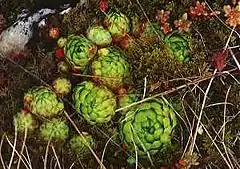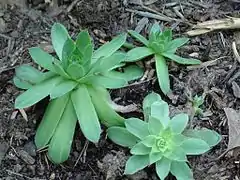Hen and chicks
Hen and chicks (also known as hen-and-chickens, or hen-widdies in south of the USA South) is a common name for a group of small succulent plants, a term that indicates a plant that possesses enlarged parts to store water.[1] It belongs to the flowering plant family Crassulaceae, native to southern Europe and northern Africa. The plants grow close to the ground with leaves formed around each other in a rosette, and propagating by offsets. The "hen" is the main, or mother, plant, and the "chicks" are a flock of offspring,[2] which start as tiny buds on the main plant and soon sprout their own roots, taking up residence close to the mother plant.



Plants commonly referred to as "Hens and chicks" include ground-hugging species of Sempervivum (houseleeks) such as Sempervivum 'Pekinese', S. arachnoideum (cobweb houseleek), and S. tectorum (common houseleek), as well as members of the related genus Jovibarba. The name is also used for some species of Echeveria, Sedum and Bergenia although these plants differ significantly from Sempervivum and Jovibarba, and may require different cultivation and care.
Care
Hen and chicks is popular in gardens for its varied and interesting appearance and hardiness. It is grown as container planting or in rock gardens. It does best in well-drained, rocky soil; if they are kept wet, the outer leaves will rot. Planting them in cactus or succulent soil will prevent your plant from sitting in water and meeting an untimely end. Commercial succulent soil is a good choice. Although it does best in sun, it will grow in light shade.
Gallery
 Two hen and chicks
Two hen and chicks A hen and chicks close up
A hen and chicks close up Multiple Hens and chicks alongside sedum
Multiple Hens and chicks alongside sedum Hens and chicks at maturity, 25 cm stalk
Hens and chicks at maturity, 25 cm stalk